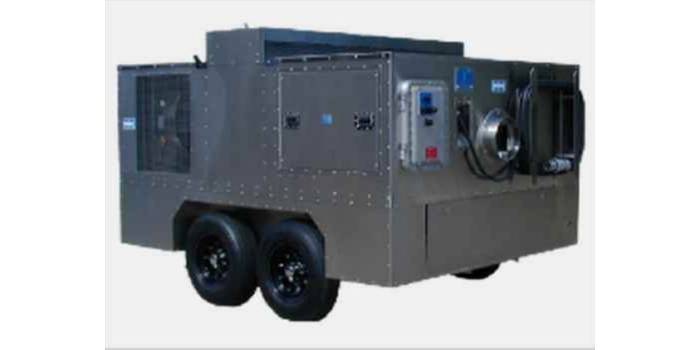 In the second part of this article we will look at some examples of classification of hazardous areas and how to request and specify an air conditioner for this type of hazardous environments.
In the second part of this article we will look at some examples of classification of hazardous areas and how to request and specify an air conditioner for this type of hazardous environments.
by Ernesto Sanguinetti Remusgo*
Some examples of classification of hazardous areas
Class I, Division 1: This is where any of the following conditions exist:
• When under normal operating conditions, there are concentrations of flammable gases or vapors. • When frequently due to repair, maintenance or leakage work, there are concentrations in dangerous amounts of gases or vapors. • When due to breakage or malfunction of equipment or processes flammable concentrations of gases or vapors can be released, and can simultaneously cause a failure in the electrical equipment and become a source of ignition.
Notes: This classification generally includes: • The places where flammable volatile liquids or flammable liquefied gases are transferred from one container to another:
• Interiors of paint spray booths, where flammable volatile solvents are used.
• Places containing tanks of flammable volatile liquids.
• Places for drying or compartments for evaporation of flammable solvents.
• Places containing equipment for the extraction of fats and oils that use flammable volatile solvents.
• Sections of cleaning and dyeing plants where flammable liquids are used.
• Gas generator rooms and other sections of gas manufacturing plants where there may be leakage of flammable gases or inadequately ventilated volatile liquids.
• Refrigerator and freezer fans that store flammable volatile materials uncovered, or in lightly covered or easily broken containers.
• All places where concentrations of vapor or flammable gases may occur during the course of normal operation.
Class I, Division 2: This is where any of the following conditions exist:
• Where flammable volatile liquids or flammable gases are handled, processed or used, but where liquids, vapors and gases are normally confined within closed vessels or systems, where these can escape only in case of accidental rupture, breakdown of containers or systems, or in the case of abnormal operation of the equipment.
• Places where flammable concentrations of gases or vapors are normally prevented by positive mechanical ventilation, and which can become dangerous due to failure or abnormal operation of the ventilation equipment.
• The site is adjacent to a Class I, Division 1 site, where flammable concentrations of gases or vapours may occasionally reach, unless communication is avoided by means of an adequate positive pressure ventilation system of a clean air source, and adequate devices are available to prevent ventilation system failures.
Notes: 1. This classification generally includes places where flammable volatile liquids, flammable gases or vapours are used, but which in the opinion of a competent authority may become dangerous, only in the event of accidents or some improper operating condition.
The amount of flammable material that can escape with force and quantity, in the event of an accident, the capacity of the ventilation equipment, the total area involved, and the history of the industry or business with respect to explosions or fires, are the factors that deserve consideration when determining the classification and extent of each location.
2.- It is not considered that pipes without valves, inspection points, meters and similar devices can generally cause dangerous conditions even when using flammable liquids or gases. Places used for the storage of flammable liquids or compressed gases within sealed tanks are not generally considered hazardous, unless they are also exposed to other hazardous conditions.
Electrical pipes and fittings thereof, separated from process liquids by means of a seal or barrier, should be classified as Division 2 locations, if the outside of the pipe and its fittings are in an unclassified area.
Class II, Division 1: This is where any of the following conditions exist:
• When under normal operating conditions there is combustible dust in the air in sufficient quantities to produce explosive or incendiary mixtures. • When a mechanical failure or abnormal operation of machinery or equipment, can cause explosion or produce explosive mixtures and can also provide the source of ignition through a simultaneous failure of electrical equipment, operation of protective equipment, or other causes. • When combustible dusts that by nature are electrically conductive, they may be present in dangerous amounts.
Note: Combustible dusts that are electrically non-conductive include dusts produced in the handling of grains and grain products:
• Cocoa and powdered sugar.
• Egg and milk powder.
• Pasta, pulverized species, starch, potatoes and flour.
• Flours produced from beans and seeds.
• Dry hay or other organic materials that can produce combustible dusts during processing or handling.
Only Group E powders (*) are considered electrically conductive for the purpose of classification.
Powders containing magnesium or aluminum are particularly dangerous, and their use should be with extreme caution to avoid ignition and explosion.
(*) Combustible metal powders, including aluminum, magnesium and their commercial alloys, and other combustible dusts, where the number of particles, abrasives and conductivity present similar danger in the use of electrical equipment.
Class II, Division 2: This is where any of the following conditions exist:
When combustible dust is generally not in the air in sufficient quantity to produce explosive or flammable mixtures, and dust accumulations are generally insufficient to interfere with the operation of electrical equipment or other appliances, but combustible dust may be suspended in the air as a result of an occasional malfunction of handling equipment or processes, and accumulations of combustible dust on or within electrical equipment may be sufficient to interfere with the safe heat dissipation of electrical equipment or catch fire through abnormal operations or electrical equipment failure.
Notes: 1.- The amount of combustible dust that may be present and the appropriate systems to remove the dust, are factors that merit your consideration to determine the classification, and may result in an unclassified area.
2.- When products such as seeds are handled in a way that produces low amounts of dust, the amount deposited may not merit classification.
Class III, Division 1: This is where flammable fibers or materials that produce flammable volatile particles are handled, manufactured, or used.
Note: 1.- These places can usually be: • Sites that use rayon, cotton and other textiles. • Manufacturing plants and processors of combustible fibers. • Cottonseed mills. Flax processing plants. • Clothing manufacturing plants. • Wood processing plants and carpentry. • Establishments and industries involved in similar processes or hazardous conditions.
2.- Among the fibers and volatile particles are those of: • Rayon • Cotton (including the fibers of ginned cotton residues and cotton waste) • Henequen • Hemp • Coconut fibers • Tow, wool waste • Mosses of different origin • Wood shavings • Other materials of a similar nature
Class III, Division 2: This is where easily flammable fibers are stored or handled. The manufacturing process may be excepted when it does not offer the danger of ignition.
Example of how to request and specify an air conditioner
If we have an environment where there are or may be gases or vapors in sufficient quantity to produce flammable mixtures and exist continuously (Class I-Zone 0), where under normal operating conditions or by frequent repair and / or maintenance there are leaks of gases and vapors in flammable concentrations (Division 1), the following substances are also present: Hydrogen or substances with a percentage greater than 30% by volume of ether, ethylene, acetone, ammonia, benzene, gasoline (Groups B, C and D), then we must request an air conditioning equipment "explosion proof" or "explosion proof" for environment Class I-Zone 0, Division 1, Groups B, C and D.
* Mr. Ernesto Sanguinetti Remusgo, Manager of the Engineering Division - Cold Import S.A. - Lima - Peru.














